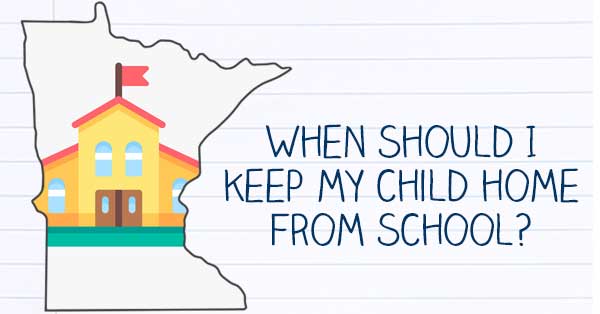This school year will be unlike any our students have experienced before, but the opportunity to return to a sense of normality with some districts offering in-person classes is exciting.
COVID-19 will pose obstacles for this school year but through the combined efforts of students, parents, and staff, we can work to make this the best school year it can be.
So how do you know when your child should stay home from school? Minnesota has outlined some guidelines for parents to follow. Let’s work to make sense of these guidelines so parents can make educated decisions on when their child should stay home.
Disclaimer: The information found in this article was taken from the Minnesota Department of Health guidebook. Guidelines can vary from district to district, so treat these state guidelines as a baseline and inquire with your child’s school for their specific information. The state may change its guidelines at any time – this article is up to date as of the 9/4/20.
Scenario 1: My Child has ONE of the “Less Common” Symptoms
ONE of these symptoms: sore throat, nausea, vomiting, diarrhea, chills, muscle pain, excessive fatigue, new onset of a severe headache, new onset of runny nose, or congestion.
Having just one of these symptoms indicates that parents should evaluate if their child is well enough to attend school. Obviously the severity of the symptoms the state lists here vary considerably, so this is left up to the parent’s judgment. A runny nose alone may not be enough of a reason for you to feel your child should stay home from school, but vomiting (for example) should be.
If you do decide to keep your child home with one of these symptoms the state recommends considering having them take a COVID-19 test. With or without a test, students are able to return to school 24 hours after the symptom has improved.
For siblings: In this scenario, siblings do not need to stay home unless the sick child’s symptoms worsen, then see scenario 2.
Scenario 2: My Child has ONE “More Common” OR TWO of the “Less Common” Symptoms
ONE of these symptoms: fever of 100.4F or higher, new onset and/or worsening cough, difficulty breathing, new loss of taste or smell.
OR TWO of these symptoms: sore throat, nausea, vomiting, diarrhea, chills, muscle pain, excessive fatigue, new onset of a severe headache, new onset of runny nose, or congestion.
Anyone with these symptoms will need to stay home. We recommend you call us (320-251-2600) or another local clinic to receive an online appointment with a medical provider to evaluate if you need to be tested. If the student’s test result comes back negative, they can then return to school 24 hours after symptoms have improved.
If a student has a positive test result (or does not seek a test/evaluation) the state of Minnesota says they will need to “stay at home in isolation for at least 10 days from the time symptoms started until symptoms improved AND no fever for 24 hours (without the use of fever-reducing medications).”
For siblings: In this scenario, siblings must stay home for at least 14 days if the student with symptoms tests positive. If the sick child receives a negative test result back, the siblings can return to school the next day as long as they do not have any symptoms themselves.
Scenario 3: My Child was in Close Contact with Someone Who Tested Positive for COVID-19
In a classroom setting, this is a scenario parents will likely encounter at some point during the year. This is something each district will probably guide parents on differently, but let’s look at the baseline the state shares.
The state defines “close contact” as someone who receives a positive COVID-19 test and is (or recently was) within 6 feet of your child for at least 15 minutes. If you are notified that your child was exposed, you should anticipate that the school district will likely ask your child to remain home for at least 14 days after their last contact with the person who had a positive case.
If your child starts to develop symptoms or tests positive after this exposure (test is recommended 5 to 7 days after the last contact), then they will need to follow either scenario 1 or 2 above.
Even if you receive a negative test result and/or have no symptoms, the child will need to stay home for 14 days since their last exposure to the person who had a positive test.
For siblings: If your child does not have a positive test or symptoms after exposure, their siblings do not need to stay home (of course some districts may instruct you otherwise). If symptoms or a positive test result do appear in the exposed student, the siblings will need to follow the directions in scenario 1 or 2, whichever is applicable.


